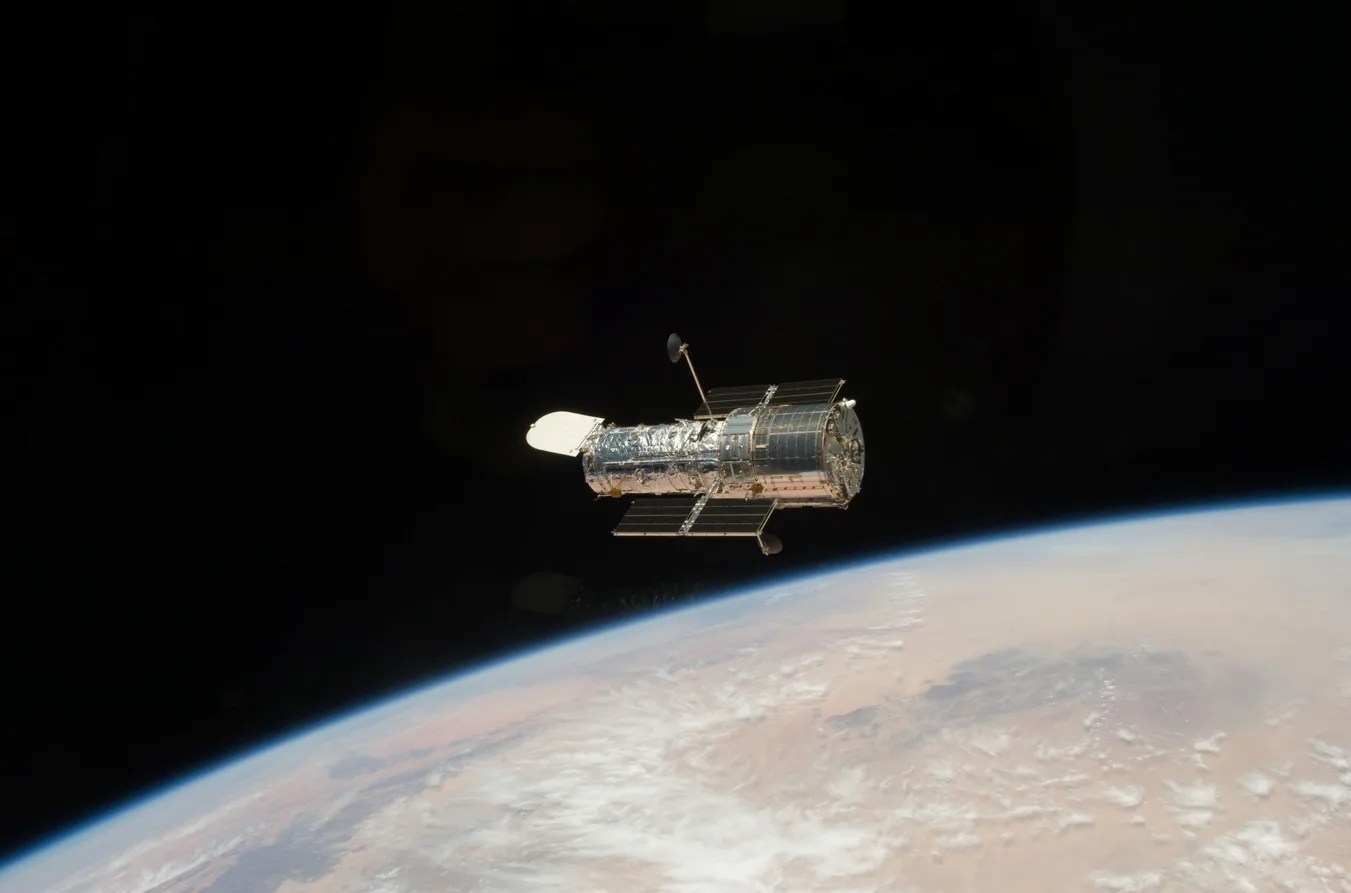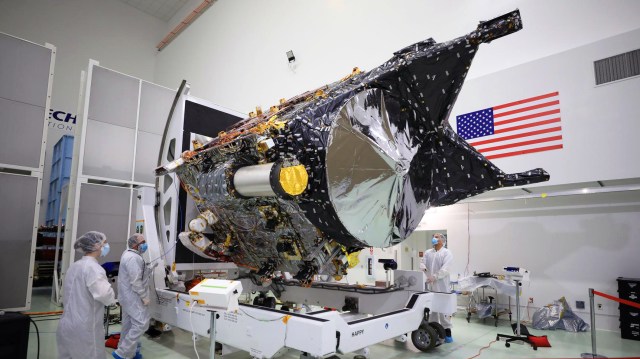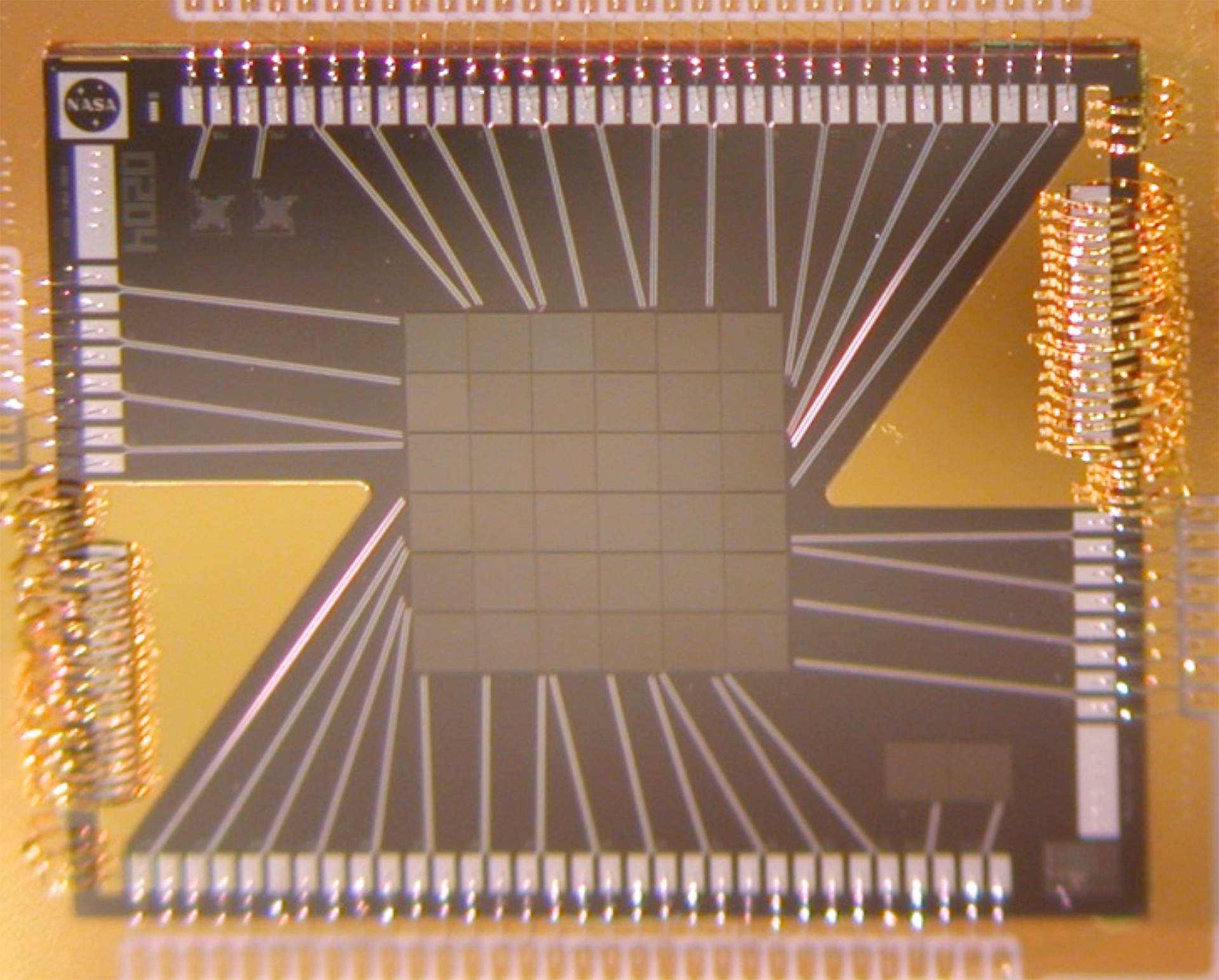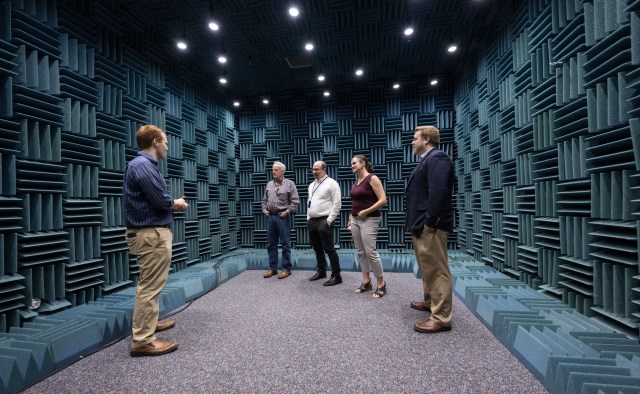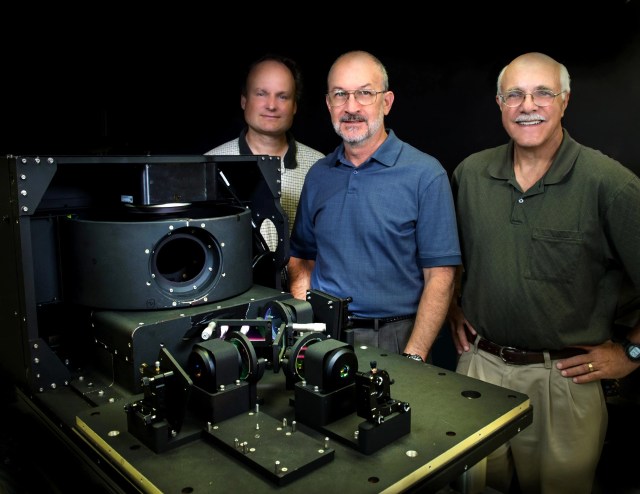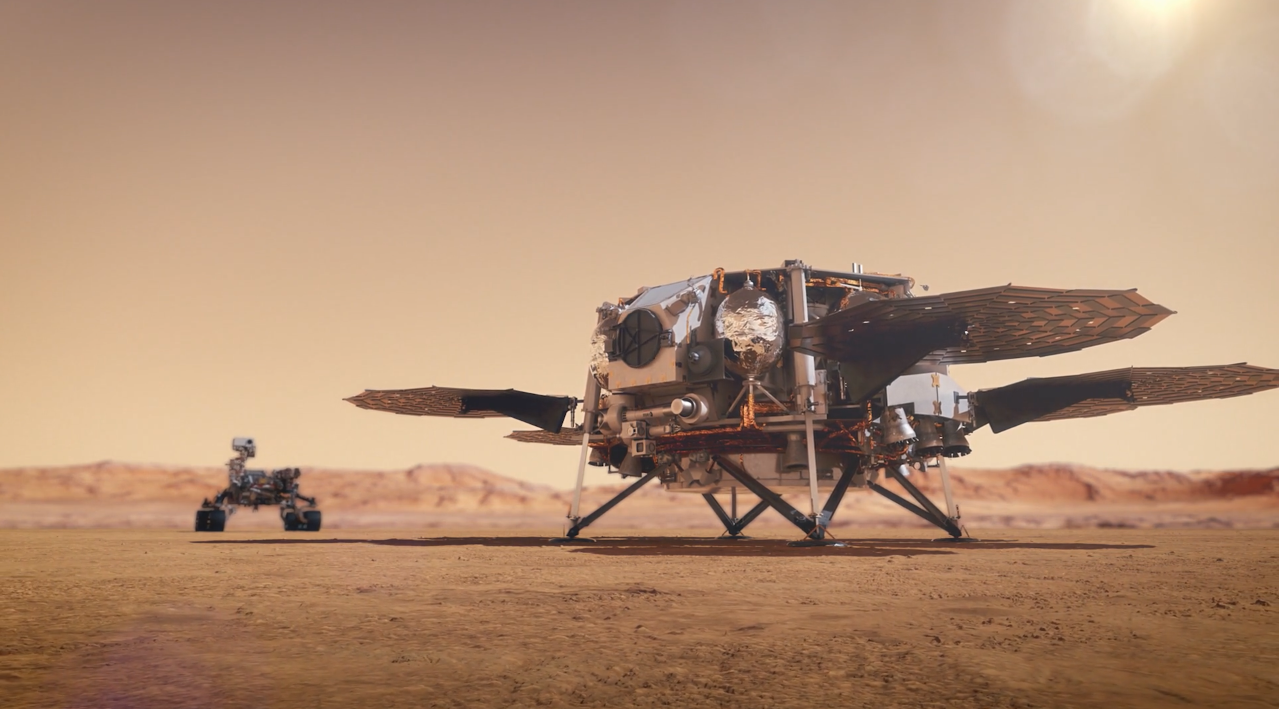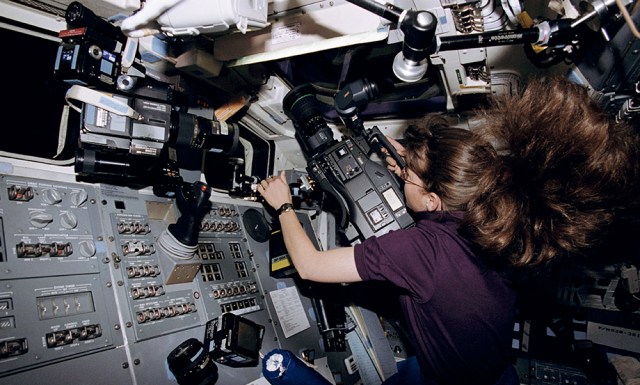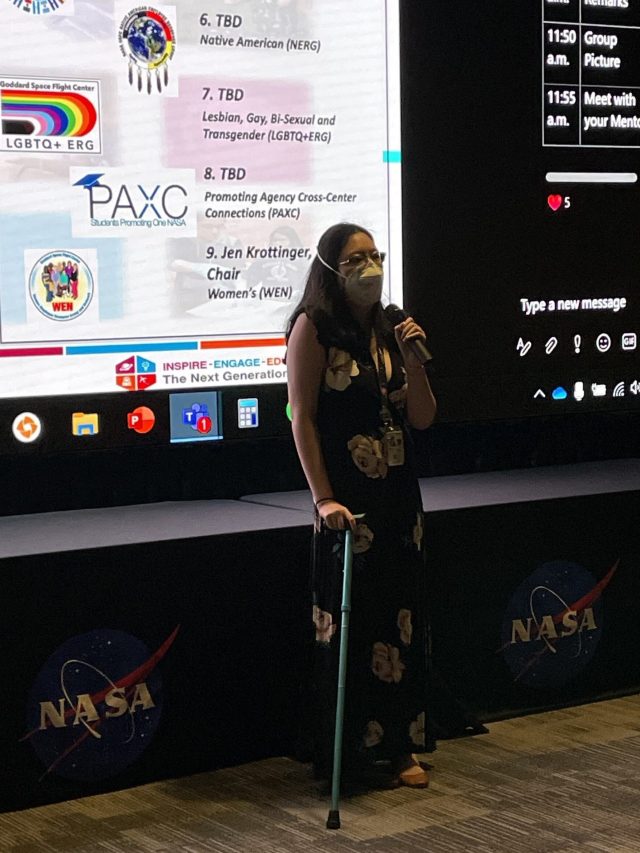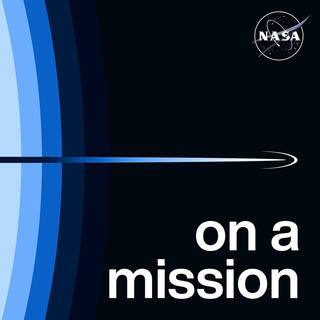
Transcript
CBS news report:CBS television presents a special report on Sputnik 1, the Soviet space satellite. Douglas Edwards reporting…
[0:09] Narrator:The space race between the United States and the Soviet Union began with Sputnik 1, the first satellite to orbit the Earth, in October 1957. The U.S. quickly responded with the satellite Explorer 1.
News Announcer:Meanwhile, far across the country at the Jet Propulsion Laboratory, a sprawling 80-acre research and development complex in Pasadena California, scientists and engineers were racing toward the same deadline, 90 days to put a satellite into orbit…
Narrator:Just a few years later, in 1961, the Soviet pilot Yuri Gagarin became the first human to leave our planet, completing one full orbit before falling back to Earth.
Reporter: I’d like to know what psychological disturbances, if any, have resulted in Major Gagarin’s space flight? Does he ever have nightmares…?
[1:02] Narrator:Less than a month after that, Alan Shepard flew into space for the U.S., and three weeks after that, President John F. Kennedy extended the space race far beyond Earth’s orbit, all the way to the Moon.
President John F. Kennedy: We choose to go to the Moon. We choose to go to the Moon…(applause)
Narrator:While such details of the space race are common knowledge, what’s not as well known is that this competition extended even farther beyond the Moon, to the planet Mars.
Flight to Mars movie trailer:For centuries, science has studied Mars, the only planet where life may exist. Now the screen creates for you the fascinating, frightening spectacle of the first flight to Mars!
Narrator:As depicted through the rosy lens of science fiction sagas like the 1951 movie, Flight to Mars, the Red Planet was a place of romance and peril, where heroes encountered bizarre creatures or more human-like Martians. Scientists in the real world were keen to discover whether Mars actually could be a haven for alien life. Here’s JPL engineer Gentry Lee.
[2:14] Gentry Lee:For many, many years, most of the scientists believed that if there was any life elsewhere in our solar system, the most likely candidate for that life was Mars. And the rationale went something like this: Venus is way too hot, the surface is 900 degrees Fahrenheit, 400 degrees Centigrade, the atmosphere has sulfuric and hydrochloric acid. Nah – no life is going to be there, at least not any life anything like we know. Mars, on the other hand, we knew that water was cycling between a gaseous and a solid phase there. So, given that water was essential for life, we focused on Mars.
(music)
[2:57] Narrator:The first six attempts to reach Mars with robotic spacecraft – five by the Soviet Union and one by the U.S. – failed, but then NASA had success in 1964, when Mariner 4 flew past Mars while snapping the closest images ever taken of its surface. That began a string of Mariner flybys, and then in 1971, Mariner 9 became the first spacecraft to orbit Mars, rather than just fly past it.
The Soviet Union’s Mars program, meanwhile, continued to struggle throughout the 1960s, but its 10th attempt – the Mars 3 spacecraft – circled the planet 20 times, arriving just two weeks after Mariner 9. The Mars 3 mission scored a first, though, by sending a lander with a rover down to the Martian surface. Although the touchdown went as planned, the lander only transmitted for a few seconds, sending one static-filled, almost abstract image, and didn’t operate long enough to release the rover it held inside.
[4:07] NASA at this time was preparing to send its own orbiter-and-lander combo to Mars – Viking 1 – followed a few weeks later by the twin Viking 2. Gentry was on the Viking team.
Gentry Lee: In the 1970s, when we were building the Viking spacecraft, we were all of us scared to death that we would fail because of all the things we did not know about Mars.
Narrator:While scientists had a better understanding of Mars thanks to the Mariner missions, many important details were hazy, and flying through the planet’s atmosphere to attempt a landing was still a dangerous dive into the unknown.
Gentry Lee: The atmospheric representations that we were given to design Viking varied by as much as three orders of magnitude. We did not know anything about the terrain. As a matter of fact, a good 20 percent of the scientists on Viking thought that the surface of Mars might be the consistency of Rapid Shave. And everybody always asks me, “Why did you take that stupid first picture of the footpad that landed on Mars?” And I said, “Because 20 percent of the scientists thought we were going to go, ‘Glub, glub, glub,’ and sink into Mars!”
[5:12] ABC news reporter Jules Bergman: Now we see the landing pad exactly as planned, with a small amount of dust or sediment lying in it. The surface has some dust, but is firm, much firmer than many scientists here had believed it would be…
Narrator: Since the Vikings set foot on Mars in 1976, NASA has sent many more landers and orbiters to Mars, as well as five rovers that have navigated the planet’s craters, sand dunes, and mountains. Mars is a more familiar place thanks to these missions, but Gentry, who is now JPL’s chief engineer for planetary science, warns against becoming complacent.
Gentry Lee: As we have learned more about Mars, and as Mars has thrown us more curveballs – and it’s thrown us a curveball in every mission – instead of becoming more humble about what we know about Mars, we have actually gotten to the point now where a number of our engineers and even some of our scientists think, “Ahh, it’s a piece of cake to land on Mars, and we know what Mars is all about.”
[6:13] Hello? You may or may not know that InSight landed on Mars carrying seismometers, which were great, and a heat probe, which was supposed to go three to five meters into the surface. And it was tested on all kinds of “Martian soils” before it went. Guess what? None of the Martian soils it was tested on were even remotely like what we encountered, and after a year of trying and trying and trying, the heat probe never went deeper than half a meter.
And I tell even my friends, “Uh-uh, don’t get cocky! Something can happen that you’re not expecting. Mars is not confined to what you think it ought to be!”
Narrator:A NASA mission exists in the space between what we think we understand, and what we want to discover. Every mission seeks to cross that threshold between not knowing and knowing, but after sending missions to Mars for nearly 60 years, it can be easy to forget just how much “the unknown” still defines these explorations.
[7:12] Gentry Lee: Almost every mission has uncovered something that we had no idea about before. We still have an awful lot to understand. And that’s what’s wonderful about it, because as we explore the planets, what happens to us is we suddenly see the Earth in a different perspective. We see the Earth in a comparative sense. How is the Earth like other places? How is the Earth not like other places? What is it about us that is so special? And I find all these questions, and all the discussions of these questions, absolutely fascinating.
(intro music)
[8:21] Narrator: Welcome to “On a Mission,” a podcast of NASA’s Jet Propulsion Laboratory. I’m Leslie Mullen, and this, the final leg of our season-four journey, is episode 12: Secrets of the Mars Rovers.
(music)
Narrator: Because Mars rovers forge paths not yet taken, engineers who design and build them need to create solutions for the unknown. This was especially true for the first rover, Sojourner, which arrived on Mars with the Pathfinder lander in 1997.
Rob Manning:So we had this chicken-and-egg problem, early on.
[9:01] Narrator: That’s Rob Manning, JPL’s chief engineer who’s had a hand in all five of NASA’s Mars rovers.
Rob Manning:Because we are going to Mars to learn more about Mars with these missions, we needed to send these missions there to find out what future missions needed to be, in order to be safe to go there.
For example, rocks that have been sitting on Mars, exposed to the very, very light wind for millions of years, despite the fact that the wind on Mars has got virtually no energy – a 100-mile-an-hour wind on Mars feels like a 10-mile-an hour breeze on Earth. So the wind is much less than that most of the time, but that still produces dust that moves, and grains of sand hop along the surface – that’s called saltation. It hits the rock, grinds it away, and produces these wonderful flat surfaces and sharpened edges. And so these rocks have really sharp points to them. Because these rocks are shaped by the wind, they’re called “ventifacts.” And many of these rocks are kind of glued into the surface, we’ve discovered over the years, and there’s a lot more of them than we thought. I wouldn’t say Mars is completely covered with them, but I have to tell you, if I was a Martian astronaut, I would insist on thick-soled shoes. I would insist, “No, I don’t want thin-soled shoes. I want steel between me and those sharp points.”
[10:15] These are the things you learn about Mars that you didn’t really know about. Because we didn’t see that – sharp rocks, that many of them – at Pathfinder’s landing site, or in the Viking landing site. But we have seen them since, as we’ve been driving around.
Narrator: Each generation of Mars rover was built on such discoveries, and became larger and more complex in the process. Toaster-oven-sized Sojourner led to the golf-cart-sized Spirit and Opportunity twin rovers that arrived in 2004, which informed the design of the car-sized Curiosity rover that landed on Mars in 2012, whose blueprint was altered in subtle and yet fundamental ways for the Perseverance rover that arrived in 2021.
[10:58] Rob Manning:This is why we’re so thankful that NASA has trusted us to do this again and again, because you can’t learn this without doing it. And so, when we built Spirit and Opportunity, we built Spirit and Opportunity on a direct melding of the functional capability of Sojourner, and a Mars Pathfinder system. So we were able to build on those capabilities and then add to them.
And I have to admit, there’s a huge advantage to doing that, because you’re adding to what you already know, as opposed to starting over all the time. And even though they look radically different, it’s no doubt, Spirit and Opportunity, Pathfinder and Sojourner were inside. And then when you come to Curiosity, there’s no doubt that Spirit and Opportunity reside inside this new ultra-complex rover, that has far more complex hobbies than anything we asked Spirit and Opportunity to do. And then we’ve upped the game even more with Perseverance.
[12:05] But just because you’ve done it before doesn’t mean, “Oh, I don’t have to build or design or test it anymore.” Every time you build it again, you have to retest all the capabilities that you layered on from previous missions. You have to check everything, because you’ve made these changes: this new hardware, this new configuration, new mass properties, everything. You have to go back and check to make sure the whole thing works. You end up with these massive teams of people who struggle to prove that all this stuff is working.
Narrator:The teams that develop, build, and test every tiny detail of the rover do the same for the landing system that will fly the rover to Mars and land it safely on the planet’s surface.
[12:45] Rob Manning:The nature of the problem we’re trying to solve is really difficult. We’re trying to send a terrestrially-invented thing, conceived by human beings, package it up, and send it to another planet. In order to get there, it has to transform itself from an interplanetary traveler, to a hypersonic pilot, to a parachutist, to a rocketeer, all the way to a lander. And then it has to be able to drive, and take images in different directions, and do it all safely. And interact with the surface of Mars so that we can understand more detail about Mars than we’ve ever seen before – far more detail than we can see from telescopes from Earth or even from orbit.
And so, the complexity of these rovers is really hard to even get your head around. The thousands of meters worth of wires, connectors, the different kinds of materials: from metals to composites to even forms of plastics. We have just a huge diversity of materials that go into building these things. We even have cork wood in many parts of the vehicle, as well as liquid chemicals we actually put on the vehicle as lubricants.
[13:59] Just the monumental numbers of things that go on to it, there’s almost a sense that it’s a fractal. If you’ve seen a three-dimensional fractal, you’ll see that the more you dive in, it gets more and more detailed, and that’s the way these vehicles seem to me. You have to go down to a level of detail that’s really microscopic to understand what goes into this vehicle. There’s so much detail to learn about and to study that it really would take a human being a lifetime to understand every nuance of these machines we build. So that’s the one aspect of the nature of the problem, is just the incredible complexity of putting all those pieces together.
The second thing that makes it very complicated is resource constraints. The nose cone of a rocket is only so wide. Our entry capsules have to fit inside that. Our vehicles have to fit inside that. All those things, layered on top of each other, are forced to be in this relatively small box on the top of a rocket. And what’s more, rockets can only push so much into outer space. Until the rockets get vastly bigger, we’ve been sort of stuck in this range of a few thousand kilograms being pushed in toward Mars.
[15:06] Narrator: The complexity of a Mars rover also stems from operating in the strange environment of an alien planet.
Rob Manning:Wouldn’t it be so nice to just use your cell phone to control the rover? We can’t. Everything we build on Earth is designed to live in roughly one Earth atmosphere. Inside this wonderfully temperate temperature we have on this planet, we’re protected by this magnetic field that deflects, like a Star Trek forcefield, charged particles from space and from the Sun. Plus, because we have oxygen made from our plants, that oxygen, as it gets to the upper part of the atmosphere, produces ozone. And that ozone layer is a wonderful filter against damaging ultraviolet light. Mars does not have those features. And because it’s farther from the Sun, it’s so much colder. The stuff that we build for Earth isn’t designed, it wasn’t invented, we didn’t evolve in that kind of an environment.
[15:58] And so, the only way for us to succeed is either build special equipment that’s somehow immune to those environments and fly to Mars, or bring Earth with you, like where you wrap your vehicle inside a thermal enclosure that at least gets the inside of the box to be closer to room temperature, as opposed to minus 100 Celsius.
Narrator: Whenever possible, a Mars rover has backups, known as “redundancies,” to help it survive expected hardships, like extreme temperature swings, but also the unexpected as every route a rover drives could end with a surprise.
Rob Manning:You have to do things to make sure that it would survive a couple of years on Mars. The only way to prove that is to put duplicative equipment on board, and have redundancy that allows the vehicle to proceed along and meet its mission objectives in the presence of bad things happening and things breaking.
And so, we have to overdesign, usually to the tune of 20 to 50 percent, if we’re lucky, to make sure that we design for uncertainties in the environment, uncertainties in our own design methodologies, and our own design mistakes, and uncertainty in our ability to manufacture these things and operate them.
[17:14] Narrator: Rob is all too familiar with how mistakes are sometimes made when developing these complex machines for Mars.
Rob Manning:We all make mistakes, and sometimes mistakes are dumb.Probably the biggest hardware damage I ever inflicted was on Mars Pathfinder.
(music)
Rob Manning: So Guy Beutelschies and I were testing the launch sequence that would prepare Pathfinder and Sojourner for launch on the Delta II rocket. Great little rocket, by the way. I love those rockets.
So we went through the sequence. The spacecraft was actually in the airlock, and it was sealed up, so it was a safe place to do testing of flight gear. And if you looked inside the airlock, what does the spacecraft look like? Does it look like it’s in the launch configuration? Well, no, it turns out the lander was over there, the cruise stage was over there, the back shell was over there. And we had all these wires jumping together so that the vehicle thought it was in its cruise configuration, but it really wasn’t, it was all spread out like the scarecrow in The Wizard of Oz. “My leg’s over there; my arm’s over there.” And these extension cords allowed them to think it’s all together.
[18:22] And so, one of the first things you do, during launch, is you turn on the freon pump that keeps the electronics cool. So, this is one of the most powerful techniques that we’ve ever had for our spacecraft is to have these reliable – cross your fingers – reliable pumps that keep the vehicle cool. Because the problem is, our vehicle’s trying to keep itself from freezing to death on Mars, yet on the way to Mars, it’s wrapped up inside a lander tetrahedron, there’s airbags around that, around the airbags is the space capsule, and this whole thing can get really hot. And you’ve got to pull the heat out somehow in cruise on the way to Mars. And so, we had this pump do that for us, pump the freon.
[19:02] So Guy and I turn the pump on. And then instantly, Larry comes out, fantastic ATLO tech, and he says, “Hey, what’re you guys doing? There’s a weird sound coming from the cruise stage.” I race over, and the airlock door opens. I was able to stick my head in. And there is this most awful sound – puhhhhcrsssssssssshhhh – coming from the cruise stage. “I’m like, “What? Oh, my God. That’s the pump.” I raced back, yelling at Guy, “Turn off the spacecraft, turn off the spacecraft, turn it off now, now, gotta turn it off!” So he does an emergency shutdown of the power.
(sound effect: Machine Power Down)
Rob Manning: And I said, “Guy, apparently the pump doesn’t like to be turned on. There’s no freon in it.” Because the vehicle’s all apart, we didn’t put any freon in there. So I had my view of a pump, you know, like many pumps, you can just turn the pump on, and it just spins without the freon. But this pump is designed specifically to float in freon, and it needs that freon for its own lubrication. I didn’t know that.
[20:02] And so, the irony of the whole thing is that the very next morning, Pradeep Bhandari, wonderful thermal engineer, and Gaj Birur, another designer of this thing, were giving a presentation on the design of the cooling system and the pump. But they didn’t know that we were turning on their pump. But by the next morning, for the class they were giving us, they certainly knew we were turning on the pump by then, but by then we had destroyed the pump. And the only way to get the pump out is to remove the whole assembly by cutting up the tubes and then tear it apart. Fortunately, we had a spare, but we had to weld in the new spare and clean the lines and flush it out. It was a huge deal. Guy and I were like holding our heads, “Oh, this is so embarrassing, so embarrassing.”
So that was a great lesson. You need to have the right people in the room when you review something; you gotta make sure that people double check and we triple check, and you ask a million people if it’s OK to do this. Now, when I do key tests, I insist that all the key people are there who know about how the equipment works.
[21:01] Narrator:Rob also admits to mistakes made for the Spirit, Opportunity, and Curiosity rovers, where electronics got fried or motors overheated to the point of melting.
Rob Manning:People might say, “Well, shoot. Maybe we should find some better engineers. This group is just not cutting it.” But these are all cases where we tried to operate the vehicle outside its design envelope. That’s almost always the case where we break something. One of the challenges with “test like you fly,” an expression we use, is that it’s really hard to test like you fly, because we’re testing on this planet. And you don’t fly them on this planet. And so, you have to be very conscious of all the differences between what you’re doing on Earth versus what’s going to happen in outer space.
And our vehicles complain so much on the ground. Curiosity was… oh, what a whiner. That rover complained about everything. “My radar’s too hot. This is too hot. I don’t like it here. Gravity’s too strong.” You know. “Oh, gosh. Would you just shut up, please?”
[22:02] The irony of the whole thing is that as soon as the spacecraft’s in space, floating in its wonderfully air conditioned, freon-cooled vehicle on the way to Mars, and then on the surface of Mars, it’s so happy. These vehicles are happy to be in these environments we put them in, because we designed them to be happy on Mars. We didn’t design them to be happy on Earth.
Narrator: Different testbeds can recreate the conditions of Mars, but not every aspect of Mars can be perfectly mimicked on Earth, and not every procedure can be performed within the confines of a testbed. So problems sometimes can stay hidden within the design, a secret waiting for Mars to reveal.
Rob Manning:Lack of awareness is part of our problem. Sometimes just knowing that the problem exists is the most important detail that we need. We’ve suffered that in the parachute world. We thought we understood parachutes, how they worked. But we tried out testing these 30-some-meter-diameter parachutes approaching Mach 2 over the ocean, out near the island of Kauai in Hawaii, and these parachutes destroyed themselves.
[23:12] And that was a real eye opener, and we discovered how little we really understood. Pathfinder, Spirit, Opportunity, all these missions, Curiosity, we had been assuming that parachute inflation looked a lot like it does on Earth, except a little bit faster. But we really hadn’t done a lot of analysis work of what that meant.
Narrator: A space capsule traveling from Earth to Mars picks up a lot of speed, and by the time it hits the top of the Mars atmosphere, the capsule is going about 13,000 miles per hour. The Martian atmosphere is only 1 percent as dense as Earth’s, but a heat shield is still needed to prevent air friction from burning up the space capsule.
(sound effects: entering Mars atmosphere, and parachute opening)
Narrator: That friction of atmospheric entry also helps slow the capsule down, but it’s still going very fast when the parachute opens, and this high speed causes the parachute to inflate in the blink of an eye.
[24:13] When the test parachutes over Hawaii ripped apart going Mach 2, or about 1,300 miles per hour, the engineers had to reconsider what they thought they knew.
Rob Manning:We realized that our parachutes were just barely working. And what I mean by barely, I don’t know, but we did not have the margin in our design, in the strength of the parachute, that we thought we had, all the way from Pathfinder.
And I realized what happened was we had tricked ourselves. We used to show these low-resolution movies of these parachutes inflating to the parachute experts, and we watched them at speeds that were slowed down. And inflating in slow motion looks a heck of a lot like inflating a parachute on Earth in real time. All these parachute experts, in their heads, they really didn’t mentally visualize that the fabric was actually moving faster than the speed of sound itself, and it can have these whip-like effects, and that could cause the parachute to tear itself apart.
[25:20] And this is where parachute experts who got together after these failures, they’re like, “Let’s see it again in real speed.” And it goes from being not open, to the next frame, to open – boom! It’s like a miracle occurred. And you go, “OK. We don’t do that on Earth.”
And so, the key here is using your imagination and asking questions, and you engage with people who are not pushovers, people who are willing to criticize you, say, “Hey, you didn’t think about this. This is a big worry; you should worry about this.”
Narrator: Mars missions take years to design and develop, but at some point, you have to make final decisions and go with what you’ve got.
[26:01] Rob Manning:When we find defects in the design, or things not working properly, we write a problem-failure report. When we’re in flight, we write an incident-surprise-anomaly report. The idea is that we’re constantly writing these discoveries up as we’re building and as we’re flying it. And when we discover our shortcomings, oftentimes we try to fix it. But more than half the time, we find ways to work around those defects. And to live with them.
Why, you might ask? We’ve got a launch date. Mars is very inhospitable about how often it allows us to go to Mars – only comes by every 26 months. And because of that, time is ticking. If you find a defect, you have to ask yourself, do I have time to fix it? And can I fix it reliably? And will the fix involve more problems than the problems I’m trying to solve? And just asking those questions is actually very time-consuming in and of itself.
[27:01] But what we often do is say, “OK, well, if it’s going to be a real problem, we have to fix it.” The thing’s not going to work without us fixing it. But it still leaves a large number of idiosyncrasies and defects in the design – some of which are discovered after we launch. Which is even scarier, right? And fortunately, many of those are survivable, or you can operate around them.
(music)
Narrator: For Spirit and Opportunity, as the clock ticked down to their launch dates, a review of their planned destinations on Mars led to a cascade of uncertainties. The rovers were scheduled to launch in the summer of 2003, to take advantage of an especially close alignment in the orbits of Earth and Mars that would shorten their journey between the planets. Spirit was to make the jump first.
Rob Manning:So we were hoping to get Spirit to Gusev Crater, and then three weeks later, get Opportunity to Meridiani Planum. And our review board challenges us; says, “Hey, you’ve got one vehicle going to a place where the rocks and slopes are so dangerous, and the winds are so dangerous, you don’t know whether you can land safely in Gusev Crater. Right now, your design doesn’t cut it. You can’t go to Gusev Crater.”
[28:16] Well, the science team is, like, devastated, because they were hoping to go to Gusev Crater because of clear signs from space that it was once a water-filled lake. The alternative for Spirit was to go to a place where we know there was no water. (laughs) That’s safe, but boring, or the wrong reason for going.
The other problem with Meridiani, you know, with Opportunity, is it was so high up, we didn’t have enough timeline margin to get to the surface, because we’d only tested the parachute inflation dynamic pressure to a certain limit in our wind tunnel tests, and so we really didn’t have the data to prove that we could land safely at that high altitude. Now, someone might point out, “Well, it’s still below sea level Rob, it’s not that high.” I know, we were still going to get to places that are well below sea level. Anything higher than that was completely off limits for our design.
[29:05] Narrator:“Sea level” on bone-dry Mars refers to the average altitude around the planet. All of NASA’s Mars missions that have parachuted down through the planet’s atmosphere have landed in the lowest areas possible. There needs to be enough airspace between when you enter the top of the atmosphere, and when you touch the ground, to give you time to cut your speed from 13,000 miles per hour to almost zero.
For Spirit and Opportunity, after the parachute opened and retro-rockets further slowed the descent, airbags would inflate around the landing platform that encased the rover. Then, this rover-lander-airbag ball would drop free of the parachute and bounce across the surface of Mars before rolling to a stop.
(sound effects: Mars Exploration Rover airbag landing)
[30:00] Narrator:It can take months of haggling for scientists and engineers to agree on where to land a Mars mission – the perfect spot has all the qualities needed for the landing system, and also has interesting geology or chemistry for scientists to study. But now, because the engineering team hadn’t proved they could handle higher winds in Gusev or the higher elevation of Meridiani, these agreed-upon landing sites were suddenly in doubt.
Rob Manning:So we had two vehicles that were on the rocket, ready to go, and we hadn’t officially selected a landing site for either one of them. “So where are you going?” “Well, we’re aiming for Mars, for both of them.” “Great. Where are you landing?” “Well, we don’t know exactly yet. (laughs) We haven’t decided.” It’s like, holy smokes.
Now, we knew we had backup landing sites that we certified were safe, but scientists were like, “Nah, let’s not go there.” So Steve Squyres, the PI for Spirit and Opportunity, implored me like, “Rob, we’ve got to find a way to prove that we can get to these landing sites.”
[31:01] And so we said, “OK, well, one thing we can do for Meridiani: we can go back and test the parachute design like we did earlier, but test to higher dynamic pressure conditions so we can validate opening the parachute up higher, faster, and show that we have sufficient timeline margin to get to the surface of Mars before hitting the ground before we were ready.” And he says, “Yes! Let’s do that, let’s do that!” So we started testing parachutes after launch, OK?
Oh, what about Spirit? Well, the wind gusts were so severe that we’d already done a whole bunch of things to deal with winds. We’ve added rockets. We’ve added a camera to estimate horizontal velocity. So what we needed was some way to tune the firing of those rockets better, to fight that wind. So we said, “OK, we’re testing rockets now.”
Meanwhile, Dara Sabahi, who’s working on key mechanical issues, he said, “We’ve got to test higher-speed horizontal velocities with airbags. We haven’t shown that we can land on rocks at the kind of grazing angles that these rockets are going to give us. So we said, “OK. I guess we’re testing airbags, too.”
[32:06] So we’re testing airbags, rockets and parachutes – all after launch. You tell people that, they go like, “What? How does that work?”
Because if these tests fail, we have a backup landing site that is scientifically not nearly as interesting as where we’re headed. And so, they were still safe to do the launch. But once these tests were done – and we did it all the summer immediately after launch – we showed the data to the landing site group selection committee, and we said, “We finally have proof.” And they said, “Yes, you can go to these two places.” And so very quickly, we did our trajectory correction maneuvers, each one, and we aimed them to their final destinations.
MER Spirit Mission Control:Signal indicates we are bouncing on the surface of Mars, (cheers) this is a very good sign…
[32:56] Narrator: Both Spirit and Opportunity landed safely in the desired locations, and because they were exploring opposite sides of the planet, each rover had very different journeys. But they also had different experiences because, despite being twins that were built side-by-side, they were still unique, with personal traits and flaws that stemmed from a million decisions and actions made during their construction.
Even if a Mars rover could be built perfectly, the ideas that shape a mission also have room for improvement. For instance, the Perseverance rover is now drilling into Mars and collecting rock cores that may contain evidence of past life. Whenever a planned future mission could bring those Mars samples to Earth, Gentry thinks they’ll likely upend expectations.
Gentry Lee:I’m going to make a bold prediction right now that after we get the samples back and we study them with the laboratory experimentation that we have available today, we will discover that our experiments and our machines and instruments are not good enough to answer the questions that we wanted to have answered, and that we have to build something new.
[34:07] (music)
Gentry Lee:I think that there is a fundamental breakdown in the human mind that goes something like this: “The more information I accumulate, the less uncertain I’m going to be.” And that is not a true statement in general. So we have now enormous amounts of information about Mars, and that guides us in everything that we do. And we don’t stop long enough to think about, “Hmm. Maybe I don’t really know this particular fact.”
I’m going to go all the way back to Viking. On Viking, we carried three biology instruments and one organic chemistry experiment. And since it was the first mission ever to go to Mars, we had the most awarded group of scientists you can imagine. There were two Nobel Prize winners, and five or six others explained to me why they should have won the Nobel Prize. And we designed these instruments based on what Josh Lederberg, a Nobel Laureate, said was an Earth-chauvinist attitude towards what life on Mars would be like. In other words, we went looking for what life would look like on Earth, assuming that if it were on Mars, it would look more or less the same way.
[35:18] And guess what happened? We got ambiguous results. And when those ambiguities came down, we were not prepared to deal with what the ambiguities mean, because we had never once spent any amount of time asking the question, what if the answers are A, B and C, and therefore ambiguous?
So the point that I’m trying to make here is that every single time we think we know what we’re doing, something comes up that makes us change our mind
War of the Worlds radio drama (1938)Pierson: From a scientific viewpoint, the stripes are merely the result of atmospheric conditions peculiar to the planet.Phillips: Then you’re quite convinced as a scientist that living intelligence as we know it does not exist on Mars?Pierson: I’d say the chances against it are a thousand to one.Phillips: And yet, how do you account for those gas eruptions occurring on the surface of the planet at regular intervals?Pierson: Mr. Phillips, I cannot account for it.
[36:14] Narrator:Viking scientists were as doubtful of advanced Martian life as Professor Pierson, played by Orson Welles in his 1938 radio drama War of the Worlds. The Viking experiments instead were designed to test the Martian air and soil for any evidence of tiny microbial life. But still, the general uncertainty about what surprises might await on Mars is illuminated by a story Gentry tells about the famous astronomer Carl Sagan, who was on the Viking team.
Gentry Lee:Now, at one time, we had planned to have lamps on the top of the Viking landers that would provide light at night so that we could see what was going on at night. Well, it doesn’t make much sense today how much those lamps cost, but it was a lot of money and we decided to decommission the lamps.
[37:02] And I will never forget, we were all in this meeting together, and Carl stood up, and in his most flamboyant way, he said, “Oh, my goodness. Just think what human beings in the future will say when they discover that we have turned off the lights on Mars. And every day it’s possible that as the Sun comes up, our cameras will see these tiny tracks in the Martian soil from the nocturnal animals that we did not see.” (laughs) We canceled the lamps.
Narrator: Carl may have been exaggerating for dramatic effect, but Gentry was impressed by his ability to make even the most technical concepts thrilling, and, by doing so, shining a light into the darkness.
One day, soon after both Viking landers had arrived safely on Mars, Carl said he was frustrated by how news stories were failing to capture the excitement of the mission. As a solution, Gentry suggested they make a TV series about space exploration.
[38:05] Gentry Lee:And he said, “How would you do that? You don’t know anything about making a TV series.” And I smiled and – I was a cocky youngster, I have to say, and I apologize to anyone who’s offended by my immodesty at the age of 34 – I said, “I didn’t know a thing about landing a spacecraft on Mars seven years ago, and we just did it twice.” So on the day after Christmas in 1976, in my backyard by my swimming pool, Carl and I outlined together in a four-hour period, 13 episodes of a TV series, at that time it was called Man in the Cosmos, that later on became Cosmos.
And so, I began the job of trying to sell it. And I had a lot of good responses, but nobody was signing on the dotted line. I just asked the blunt question, “What’s holding people up?” And finally, KCET, the PBS station in Los Angeles, said, “Your ideas are great, but they don’t think that you and Carl know anything about making a TV program. You don’t have any TV professionals.” I said, “Well, that’s easy. I’ll hire one!”
[39:10] So I did my research. I looked at program after program after program, and I decided that the best candidate to be our director and executive producer was a man named Adrian Malone, who had just finished the same job on Jacob Bronowski’s The Ascent of Man. And so, I called him. I said, “You’re in London. We’re in California. Why don’t we meet in New York and talk about the possibility?” Carl and I flew to New York, and we met. He agreed to do it. Very soon thereafter, all the sponsors signed up, and off we went.
And we had an amazing time making that television series. And as I’m sure everyone knows, it won many Emmys, has been shown in 60 countries, the book was on the bestseller list for two and a half years, et cetera, et cetera. It was an amazing experience.
(Cosmos theme music)
[40:04] Narrator: Gentry’s own origin story also began in New York.
Gentry Lee:I was born in New York City in March of 1942. And I lived in rowhouses: 75-21 167th Street in Queens, New York. I can still remember jumping from rooftop to rooftop with my next-door neighbor, Brucey Extrum. And my father worked all night for the Associated Press, and he decided that was not a good job, and he took a job as a journalism professor at the University of Texas in Austin. And so I was in Austin, Texas, for many, many years. They started noticing something about me that was unusual, and I started taking courses at the university at a very, very young age. So that was where I did my undergraduate work. And then I went to MIT to graduate school. And I went to the University of Glasgow in Scotland, but I decided I had had enough of being poor and I didn’t want to stay long enough to get a PhD.
[41:03] And I remember walking on a beach and asking myself, “OK, now I have lots of choices with what I do with my life. What might I do that would have the most historic mettle and would give me the most satisfaction in terms of the things that I love the most in life?” And learning is a very high part of that. And I said, “Well, that’s clear. We’re about to embark on the exploration of the solar system. It will be the first time that humans have ever done it, and it represents an epoch in human history, not unlike what happened when the explorers discovered what the world was all about.” So I said, “That’s what I’m going to do.”
And so I left and I began my career in aerospace. I was at Lockheed Martin. I wrote part of the proposal for Viking and then worked on Viking for seven years. After Viking successfully landed on Mars, JPL approached me with an offer I could not refuse to start working at JPL. And I get to take part in all the stimulation, all the challenge of building spacecraft to go and answer questions, some of which we didn’t even know how to ask a few years ago.
[42:07] Narrator: Before he left college to explore the universe, Gentry’s experiences as a student led him to a surprising conclusion.
Gentry Lee:I had a very rude awakening when I went to graduate school at MIT. I graduated from the University of Texas at Austin with every award and honor you could possibly have. And I was not yet 21 years old, and I mistakenly thought there was a chance that I might be the smartest person in the world. (laughs) Of course, I was dead wrong. And I went to graduate school at MIT and I learned, “Oh, my gosh, there’s a whole lot of other people who are just as smart, maybe even smarter than I am. How am I going to make my way in life?” And I realized that the only way that was going to happen would be if I developed other skills, other than just science and engineering.
[43:01] Communication skills, writing, speaking, bringing people together, understanding human nature, and all those things would serve me equally well in a team arena as my science and engineering knowledge. And I have made many deep connections with people throughout my career because we have worked together to solve difficult and challenging problems.
Narrator:One such connection led to a collaboration with the science fiction writer, Arthur C. Clarke.
Gentry Lee:In 1986, a friend of mine wanted to get Arthur Clarke involved in a movie, but was told that Arthur wouldn’t see him unless he brought someone of interest to Arthur. So the guy called me and said, “Will you go to Sri Lanka with me?” Because Arthur lived in Sri Lanka. I said, “OK, why not? I’ll do that.” This looked like an opportunity for an adventure of one kind or another.
[43:59] So off we went to Sri Lanka. And to make a long story short, Arthur had no interest in the movie, but Arthur and I had dinner together, and he says, “You have a very interesting mind. Have you ever thought about writing fiction?” And I said, “Yes, I wrote fiction when I was in college, and I’ve been keeping a notebook full of ideas ever since. And so he said, “Tell me an idea.”
Narrator: Gentry’s story idea led to deeper discussions that eventually became a book called Cradle. The two also worked together on sequels to Arthur’s novel, Rendezvous with Rama.
Gentry Lee:And how did we work? Well, I did all the writing and he worked with me on all the plot ideas. So I would fly to Sri Lanka. We would spend a week or 10 days together. Then I would go back and write and send him stuff to edit. And then we would go back and we would work on more of the plots. And that was the way we did it.
And I have never met a human being in my life with as many ideas as Arthur C. Clarke. He was a colossal genius. You know, he invented communication satellites. He wrote a paper with the British interplanetary society in 1948 pointing out that there were places where spacecraft could be in orbit over the Earth and stay there, and you could use them for communications. If he had patented that idea, he would have been a multi-billionaire.
[45:16] But working with him was such an astonishing thrill. He would throw out 10 ideas in one evening that I had never heard of before. Eight of them would be poppycock. One of them would be, “Hmm. That’s really smart.” And one of them, I would have to take a deep breath and say, “Oh, my God, that is so brilliant. It’s unbelievable.” He was so full of ideas for things that could happen.
Now, “poppycock” is maybe too strong. How about “not plausible”? In fact, when Arthur and I started writing science fiction, we had to reach a general set of guidelines and policies that we both agreed upon. And what we decided was a fair statement of our approach was anything that we wrote about had to be not implausible, meaning it might be possible for the science and engineering to work. That was the way we wrote Cradleand all the three Rama novels. Now, we have aliens in our novels, and I’ve had some people tell me that that’s not plausible, but every alien that we describe in all of the books has a backstory that is not implausible.
[46:21] (music)
Narrator: NASA’s missions often can seem like barely plausible science fiction – until the engineers and scientists manage to pull it off. But even mission failures are a necessary part of success, because that points to where improvements are needed. As Arthur C. Clarke wrote, “The only way of discovering the limits of the possible is to venture a little way past them into the impossible.”
Every mission builds on the lessons of the past, but also aims to extend further than we have before, and so often finds new questions as well as answers. The uncertainties Mars rovers face can seem daunting and even dangerous, but after they leave Earth they’re not entirely on their own, because we carefully guide them throughout their journey. Gentry says that could change in the future.
[47:19] Gentry Lee:Send a robot to Mars, but carefully monitor everything it does and tell it what to do. (laughs) Next step, send it to Mars on its own. It would be a lot more work in the development. It would just be less work when you fly.
And we could do that right now with an Earth-orbiting mission. It wouldn’t be that hard. And I have been all for building a complete hands-off spacecraft that we send up with the highest order of instructions: “Do A, B, C and D. And here’s what you have that you can use to do it. Tell us what you decided to do, and why, and what you found out. Goodbye.” Wouldn’t that be fun? Can you imagine how much fun that would be?
[48:11] But every time I say it’s time to do that, they say, “We’re not ready. We’re not ready.” And is it, I wonder, something about human beings that like to believe they’re essential?
Now, that is what will happen sometime in the future. If we build interstellar spacecraft, they will be so far away from us that our ability to interact with it will be almost useless. And so, we will have to tell them what it is their mission is, what their instruments are, the different ways they might deploy them, and then they will send the data back and we will receive that data long after their missions have been accomplished, or not, depending on how clever we were in building them.
[49:03] Narrator:All spacecraft, including Mars rovers, are as clever and flawed and vulnerable as the humans who made them, and perhaps that’s part of the reason it can be bittersweet to let them go. But when the time comes, they must go, to either succeed or fail, because that’s what they were made for.
The advanced technology of Mars exploration may not seem indistinguishable from magic, to paraphrase another quote from Arthur C. Clarke, but Rob Manning practices his own enchanting tradition to wish the rovers good-bye and good luck.
Rob Manning:When Pathfinder left JPL, we put it in a truck, and went through the main gate. It was at night. We often leave at night to avoid traffic. And it was intended for the long drive on Interstate 10 all the way to Florida. Before we left, “Hey you guys, we need to do a send-off. Let’s make some noise!” “Okay, well, I have a noisemaker. I can bring my trumpet; I could play Saints Go Marching In.” “Perfect! Yeah. Come on.” So we hung out there just outside the main gate, a small group of people, and I pulled my trumpet out in the middle of the night, I just started blowing.
[50:04] (recording of Rob Manning playing When the Saints Go Marching In at JPL)
Rob Manning:Had a raucous send-off to see it go. Meanwhile, the truck driver looked at us and just rolled his eyes like, “Oh yeah, these crazy people.”
So I did that for Pathfinder. And then I didn’t do that for Mars Polar Lander and it didn’t work! So I said, “Well maybe I should pull my trumpet out when Spirit and Opportunity left.” So I did the same thing for Spirit and Opportunity. And then I did again on Curiosity. And then I did it again for Perseverance.
(When The Saints Go Marching In ends.)
Rob Manning:How was that? Crowd cheers and applauds.)
Narrator: We’re “On a Mission,” a podcast of NASA’s Jet Propulsion Laboratory. If you liked this episode, please follow and rate us on your favorite podcast platform, and be sure to check out NASA’s other podcasts: they can all be found at NASA dot gov, forward slash, podcasts.
(Episode length = 51:13 minutes)


